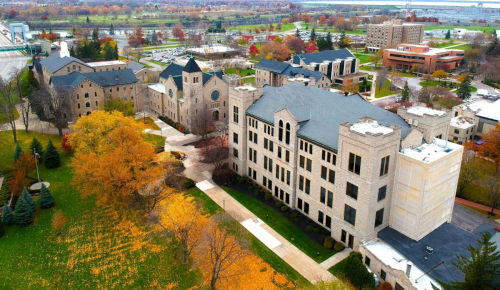As June comes to an end and high school students finish up their year, many of them are preparing to move on to higher studies.
The vast majority of students bound for higher education will be headed to Canada’s publicly assisted colleges and universities. A handful might head south of the border, where there is a mixture of publicly supported and private colleges and universities. However, very few students destined for higher education will enrol in one of Canada’s private universities. Those institutions haven’t flourished on this side of the border as they have in the United States and elsewhere around the world.
The question is: why haven’t they?
In the interest of disclosure, I will say that I have extensive experience with the publicly assisted university system. I got my PhD from McMaster and worked as a full-time faculty member at both Wilfrid Laurier University and the University of Western Ontario. I had positive experiences at them, and don’t for a second say otherwise.
I have also worked with private institutions. I am currently a faculty member at Niagara University in Lewiston, NY, and have advised a private university startup at the International Business University (IBU). I have also worked with private career colleges and training institutes, language schools, and other degree-granting institutions. Each type of university I have had the privilege of working with has had its merits and its drawbacks.
“The point is that true choice requires a spectrum of offerings to meet the needs of students, society and the economy.”
However, private institutions in Canada are often unfairly painted with a particular brush: they are degree mills, anybody can get in, quality is inferior, tuition is sky-high, they are fly-by-night operations. It is as if American private universities do not exist — those same private universities that are ranked among the best in the world.
Criticisms levelled at Canadian private universities also often fail to acknowledge the challenges that can exist at publicly assisted universities: enormous class sizes, an overreliance on sessional adjunct instructors, students who are just numbers that fall through the cracks.
Publicly assisted universities have even had run-ins with financial insolvency (see Laurentian University in Sudbury, ON ). This, despite the fact that publicly assisted colleges and universities are supported by billions of dollars just to open their doors. Cost controls are difficult as faculty compensation continues to grow and full-time faculty teach fewer courses each year. In fact, the Council of Ontario Universities recently put that number at 3.2 courses per year for full-time faculty members.
Public and private universities each have their merits. Where one system has big classes, the other has small ones. Where one has higher tuition, the other system has lower. The point is that true choice requires a spectrum of offerings to meet the needs of students, society and the economy.
Take, for example, this story in the Financial Post. Businesses are concerned about the length of time students take to complete university degrees and about their job readiness once they graduate. This is an issue private universities are perfectly positioned to solve.
There are at least a couple of identifiable issues highlighted here. The first that degrees take too long, and the other is that students are not job ready when they are done. This was the genesis of startup IBU’s accelerated BComm in International Business and Technology. One of the key differences between the IBU program and its competitor business programs is that the IBU degree uses the traditional summer months for learning. Thus, a student can get a four-year honours degree in less than three years. Not bad. Also, the IBU program is moving toward competency-based education to ensure that its graduates have the skills employers want.
Is it for everyone? Not exactly. Lots of students like the summer months to earn a little money, travel, and recharge. However, there are students who want to get in, learn, acquire the skills and get on with working as quickly as possible. IBU’s program offers that option.
From a faculty perspective, the switch for me personally has been eye-opening.
While teaching loads are heavier (six courses per year is typical), the reality is that smaller classes allow faculty members to teach multiple sections of the same course. Therefore, whereas at Western I would teach one section of research methods with 100 students, I could teach fewer students over three sections at Niagara University and that would be my entire load for the semester.
The focus on peer-review of teaching is far greater at Niagara too — peer reviews that can have an impact on tenure decisions. I’m not sure there has been a semester yet where my dean and chair haven’t sat in on a course to provide feedback on my teaching.
Far from the common misconception, the focus on quality is high.
External accreditations authenticate and validate degree quality. In my experience, private institutions are focused on delivering quality and key performance indicators as a function of their recruitment success. I oversee the Teacher Education program at Niagara University’s location in Vaughan, ON. Our applications are high and are acceptance rate is low, comparable to many of the public institutions we compete with. In the case of that teacher education program, it is accredited by the Ontario College of Teachers like every other teacher education program in the province.
The point is not to say that one system is better than the other. Rather, we should be enabling choice. There is a predictability with public universities. Differentiation among those institutions typically is found at a program level, but the governance, structure, and approach has a fair degree of uniformity. It is also a system that is expensive and designed by its ardent supporters to keep wages trending higher and workloads trending lower.
With public dollars for those institutions waning, the focus becomes packing classes and propping up the financial bottom line with international students.
Providing more options for students to address their needs, as well as the needs of their future employers, makes a lot of public policy sense. Plus, the biggest benefit is that it opens up spaces in higher education without costing the government a dime.
Recommended for You

Carney’s debut budget misses the mark

‘This budget gets a C grade’: What Mark Carney’s big-deficit budget gets right—and where it falls short

Carney’s budget breakdown: Interactive graphic shows deficit spending, taxes, government transfers, program spending, and more

Will there be another federal election in Canada?: A timeline if Carney’s budget fails





Comments (0)